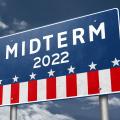
ALL OUT WAR!
Background
Since the 1973 Roe v. Wade decision that legalized abortion across the country, the issue has been a dividing line in American politics, with Democrats generally in favor of abortion rights and Republicans generally opposed.
Though, gray areas existed in the 1970’s, voters of both major parties had an implied consensus that abortion should be legalized. Four states permitted abortion on demand and fourteen others permitted it under limited circumstances in the early 1970s. The problem was not seen as a partisan one by voters. When asked whether abortion should be legal under any circumstances, 39% of Republicans and 35% of Democrats agreed in 1977.
The issue was seen as a threat to traditional values by conservative activists like Phyllis Schlafly. Abortion, gay rights, higher divorce rates, and women's paid employment were all seen by these groups as dangers to the traditional family unit. Abortion, according to UC-Davis legal historian Mary Ziegler, became a stand-in issue for worries about a liberalizing society. It was a matter of "family, women, and sex" for many evangelicals. In 1980, the Southern Baptist Convention changed its mind on abortion.
With Reagan in office, those who are against abortion had a powerful ally there. Women's rights activists pushed Democratic Party officials to support abortion access. Opposition to Roe was bipartisan. In 1983, a constitutional amendment to overturn Roe v. Wade received support from 34 Republicans and 15 Democrats.
The electorate tends to go along with the policies that its elected officials favor. It was towards the end of 80’s era that politicians picked the sides and voters started following.
In 1988, pro-life Republican George H.W. Bush won the president despite his history of supporting abortion rights. Republican George H.W. Bush lost to Democrat Bill Clinton, who now supports abortion rights, in 1992.
OpenSecrets, a website that monitors political donations, reports that since 1989, abortion-rights groups have given $32 million to Democratic candidates and $3 million to Republican candidates who support maintaining abortion's legality. A total of $14,000,000 has been donated to Republicans while just $372,000 has been provided to Democrats by anti-abortion groups over the same time period.
The voters took longer to organize themselves. In 1991, 45 percent of Democrats and 41 percent of Republicans stated they were okay with abortion in any circumstance, according to the General Social Survey.
As the subject became a mainstay of TV attack commercials, fundraising appeals, and major rallies by interest organizations, partisan divides grew in the years that followed.
Only 31% of Republicans backed abortion on demand by the turn of the century, while support among Democrats remained stable at 45%.According to polls, the majority of Americans are in favor of limiting abortion access but are against a complete ban. Growing numbers of Democrats now back protecting women's right to have abortions. Though he had previously opposed providing Medicaid coverage for abortions to low-income women, Biden changed his mind in 2020.
One Democrat in the House and none in the Senate were opposed to a bill that would have legalized abortion across the country. In the upcoming midterm elections in November of 2022, Democrats hope to make the bill a central issue.
Among Democrats, 71% now back legal, unrestricted abortion, up from 56% in 2016, while only 34% of Republicans share this view.
Most Americans, according to a number of different polls, are fine with putting limits on abortion but would be against outlawing it entirely.
Republicans appear to be adjusting / softening their antiabortion position
In the recent developments that followed the reversal of Roe v. Wade by US Supreme Court in June 2022, there is evidence that some of the Republican candidates for Congress are trying to modify their more hardline attitudes on abortion as they transition from the primaries to the midterm election.
Democrats, independents, and some moderate Republicans were galvanized by the Supreme Court's overturn of Roe v. Wade two months ago. Soon after the decision, voters in Kansas passed a constitutional amendment protecting abortion rights, and a House candidate in upstate New York won a special election by making abortion his primary platform.
For this reason, Republicans in difficult contests in states like Michigan, Iowa, and Arizona have been forced to moderate their attitudes on abortion rights or risk alienating a passionate subset of voters.
Arizona Senate candidate Blake Masters can be cited as a recent, who recently removed his support for a "federal personhood statute" and a number of other severe anti-abortion policies from his website and released a video in which he expressed a more moderate stance on the topic. Masters' website previously stated that he was "100% pro-life" and listed his support for a constitutional amendment that "recognizes unborn babies as human beings that may not be killed" as well as a number of other bills that would make it illegal to perform an abortion 20 weeks after conception. However, he is far from alone.
Another, Tom Barrett, a congressional candidate in Michigan who had branded himself "100% pro-life — no exceptions" in the wake of the Supreme Court ruling, removed the phrase at the month's end and especially in light of the results in Kansas.
Doug Mastriano, the Republican candidate for governor of Pennsylvania and a staunch opponent of abortion, has recently been quoted as claiming that "the people of Pennsylvania" rather than the government will "decide what abortion looks like" in the state. Minnesota gubernatorial candidate and family physician Scott Jensen, who in March indicated he would "attempt to outlaw abortion," clarified his position in a video broadcast before the Kansas vote by saying, "If I've been confusing earlier, I wish to be clear now."
Democrats' unwavering backing for abortion rights has hardened recently
Throughout his political career, Biden had backed a ban on federal funding for most abortions through the Medicaid program for the poor. However, when he ran for the Democratic presidential nomination in 2020, he changed his mind.
In a dramatic turnaround, Democrats found themselves on the offensive in America's political culture wars, casting the Republicans as wildly out of touch with public opinion, which shows overwhelming majorities favoring Roe v. Wade, if not abortion access in all circumstances.
The abortion controversy has thrown a wrench into a midterm election cycle that had seemed hopeless for Democrats for months. Democrats have been buoyed by the victories in Kansas and New York, which they have used as evidence that making abortion a central issue in a campaign can be successful even when voters are skeptical of the party's leadership in Washington, while anti-abortion organizations continue to urge Republicans to go on the offensive on the issue. Democrats' conviction to campaign on the issue was bolstered by a slew of national polls showing widespread disapproval with the Supreme Court's ruling in June.
To that end, with only a couple of months left until the November election, Democrats are eager to point out the Republican softening, saying, the party is trying to mislead voters and disguise its very unpopular positions on abortion rights.
How voters may be willing to give them the ability to do more damage?
Democrats have made the rhetorical case that abortion rights are a matter of individual liberty, while Republicans have attempted to shift the focus by claiming that Democrats want to revoke protections that women have enjoyed for decades.
According to a recent CBS News Battleground Tracker poll, over 40% of prospective voters indicated they would vote for Congress if they supported abortion rights, while only 16% said they would vote against those rights.
Even Democrats have backed abortion-related advertising with big funding. AdImpact reports that of the $73 million spent on political advertising mentioning abortion, nearly $57 million has come from Democratic campaigns and parties.
Anti-abortion rights groups are ready for their candidates to not just hold the line, but go on attack on the issue, connecting their Democratic opponents to what they regard as extremist pro-abortion rights views.
Due to the heated debate surrounding abortion and its prominence in the public consciousness following the Supreme Court's decision, it can be challenging to win over moderate voters in a general election.
Even though antiabortion forces are energized to vote, they were already energized before the draft was revealed, so the turnout gap is more likely to benefit Democrats.
The Democrats' slim majorities in the House and the Senate, combined with historical data that favors the party that is not currently in the White House, puts them in imminent danger of losing both chambers of Congress in fall.
The potential for deception that could further undermine the individual's right to make choices.
Protests have been observed all over the country after a draft judgment showing the Supreme Court's willingness to strip away the federal right to an abortion was leaked. Pro-choice rights forces have been particularly active, angry at the apparent loss of a right women have had under the law for nearly half a century, however anti-abortion groups have also been showing up at public demonstrations. As soon as the draft opinion was made public, the battle line for the fall elections were crystallized.
Some may asset that abortion may has been dragged into politics only to win elections. But, of course it is and if women are to have any semblance of controls over their body this battle must be waged. Republicans are trying to soften their antiabortion position for political advantage in November, but don’t be fooled. They’ve shown what their intent is, and it would be unwise to think otherwise. They’re trying to con you into to granting them even more power to inflict more harm. This is nothing more than a game of political deception that could further undermine the individual's right to make choices.

